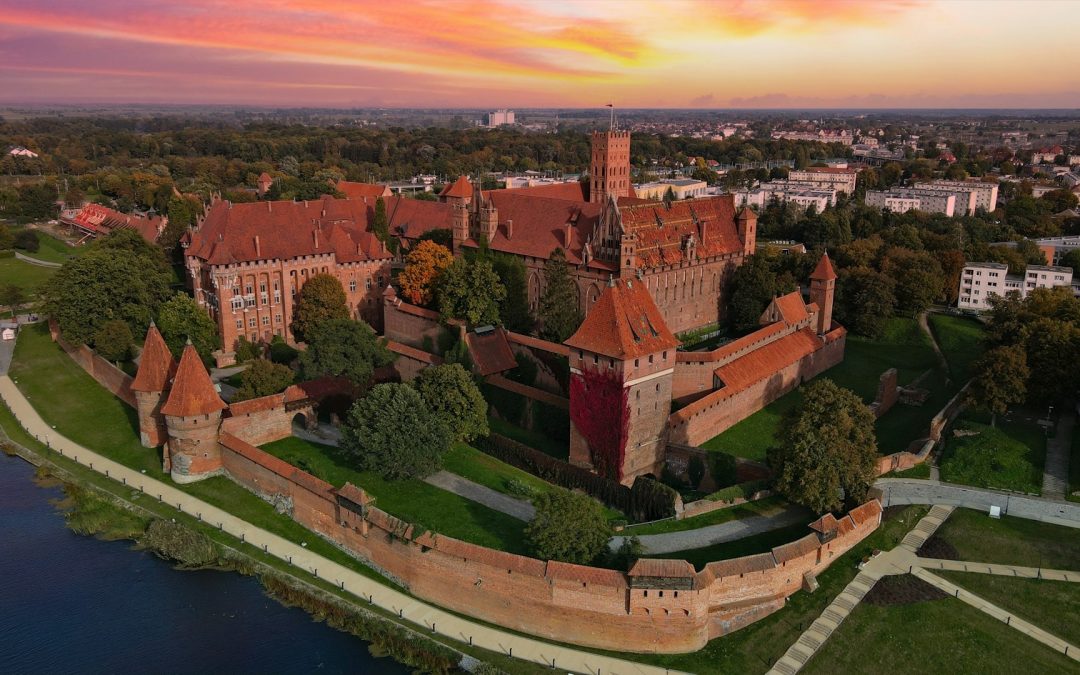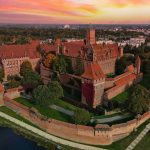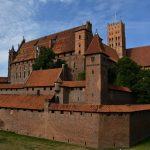Malbork Castle, also known as the Castle of the Teutonic Order in Malbork, is recognized as the largest castle in the world by land area. Situated in Malbork, Poland, this historical fortress is a UNESCO World Heritage Site and an impressive example of medieval military architecture.
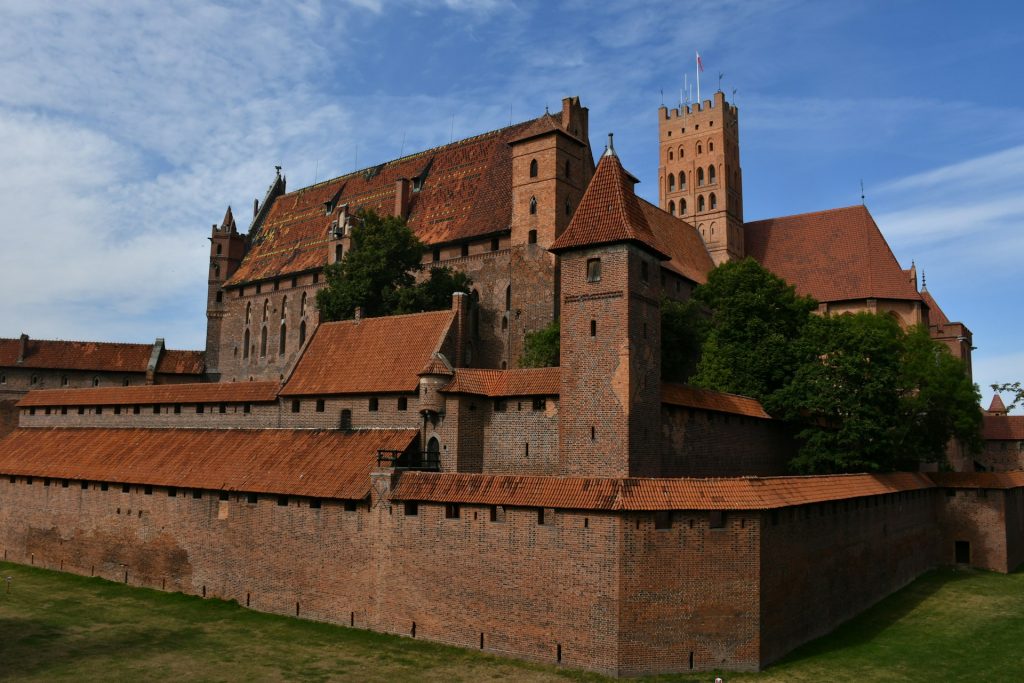
The largest castle in the world is Malbork Castle, Poland
Here are interesting insights about the World’s Largest Castle Malbork Castle in Poland:
Physical Characteristics:
- Land Area: The castle complex covers approximately 143,591 square meters (over 35 acres), making it the largest in the world by land area.
- Construction Materials: Primarily constructed from brick, it is one of the largest brick buildings in Europe.
- Architecture Style: Gothic, characterized by high walls, towers, and a complex system of moats and fortifications.
Location:
- Address: Malbork Castle is located in the town of Malbork, in the Pomeranian Voivodeship of northern Poland, on the banks of the Nogat River.
- Setting: The castle is strategically placed along the river, which historically provided natural defense and facilitated transportation and trade.
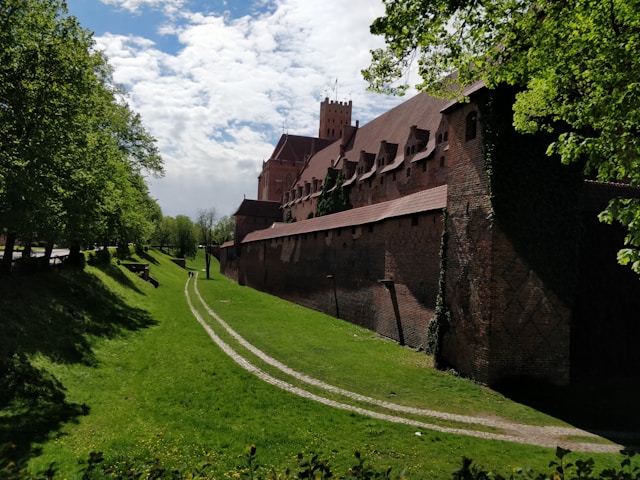
Outside the World’s largest castle, Malbork, Poland
History:
- Construction: The construction of Malbork Castle began in 1274 by the Teutonic Knights, a German Roman Catholic religious order of crusaders.
- Expansion: The castle was expanded several times to accommodate the growing number of knights and to serve as the administrative center for the Teutonic Order. Major expansions took place in the 14th and 15th centuries.
- Historical Significance: At its height, Malbork Castle served as the capital of the Teutonic State, playing a crucial role in the region’s politics and military affairs.
Architecture:
- Triple Castle Layout: The complex is divided into three main sections: the High Castle, the Middle Castle, and the Lower Castle.
- High Castle: The oldest part, featuring the church, chapter house, and convent buildings.
- Middle Castle: The administrative and residential center, housing the Grand Master’s Palace, dining halls, and living quarters.
- Lower Castle: Contains the economic and utility buildings, such as stables, granaries, and workshops.
- Defense Features: The castle’s defenses include massive walls, gates, drawbridges, and a series of moats, making it one of the most formidable fortresses of its time.
Significance:
- Cultural Heritage: Malbork Castle is a symbol of the Teutonic Knights’ history and their influence in the Baltic region.
- Tourist Attraction: It is one of Poland’s most visited historical sites, drawing tourists, historians, and architecture enthusiasts from around the world.
Popularity:
- UNESCO World Heritage Site: The castle was designated a UNESCO World Heritage Site in 1997, recognizing its historical and architectural significance.
- Cultural Events: Malbork Castle hosts numerous events throughout the year, including medieval reenactments, concerts, and exhibitions.
Visiting Tips:
- Guided Tours: Guided tours are available in multiple languages, providing detailed insights into the castle’s history, architecture, and daily life during the medieval period.
- Museum: The castle houses a museum with extensive collections of medieval artifacts, armory, and artworks.
- Best Time to Visit: Spring and summer offer the best weather for exploring the castle and its grounds.
- Ticket Booking: It’s advisable to book tickets in advance, especially during peak tourist seasons.
Fun Facts about the Largest Castle in the World:
- Brick Castle: Malbork Castle is the largest castle in the world built entirely of brick.
- Tug of War: The castle changed hands several times throughout history, being controlled by the Teutonic Knights, Polish kings, Prussian rulers, and eventually being restored by Poland after World War II.
- Innovative Restoration: Post-World War II restoration efforts were extensive; damaged sections were meticulously rebuilt to reflect their original medieval design.
Nearby Attractions:
- Nogot River Cruise: Enjoy a scenic boat tour on the Nogot River, which offers stunning views of the castle from the water.
- Old Town of Malbork: Explore the charming streets and historical buildings of Malbork’s Old Town, which complement the castle visit.
- Museum of the History of Polish Jews: Located within the castle complex, this museum offers insights into the Jewish community’s historical presence in the region.
Community and Cultural Impact:
- Economic Benefits: Tourism related to Malbork Castle significantly contributes to the local economy, supporting businesses, restaurants, and hotels.
- Educational Opportunities: The site serves as an educational resource for students and researchers interested in medieval history, architecture, and the Teutonic Order.
Malbork Castle is a testament to medieval engineering and the historical power of the Teutonic Order. Its grand scale, rich history, and stunning architecture make it an unmissable destination for anyone interested in history and culture. If you have the chance to visit Poland, exploring this monumental castle offers an unforgettable experience.
- Outside the World’s largest castle, Malbork, Poland
- The largest castle in the world is Malbork Castle, Poland

